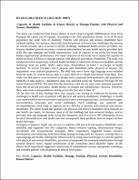| dc.description.abstract | BYARUGABA FRANCIS (2012-M191-10007)
Capacity of Health Facilities in Kisoro District to Manage Patients with Physical and Sensory Disabilities.
The study was conducted from Kisoro district in south western Uganda 500kilometres away from Kampala the capital city of Uganda. According to the 2002 population census, 16 % of the total population has some form of disability. Patients with physical and sensory disabilities have multiple burdens. For instance, physically disabled persons in Kisoro have challenges like moving on uneven terrains, lack of access to facility buildings, inadequate health service providers, etc. Sensory disabled patients encounter communication burdens because health service providers lack skills like sign language and braille interpretation. Lack of capacity is one of the key issues that hinder organisational performance. The major objective of this study was to assess the capacity of health facilities in Kisoro to manage patients with physical and sensory disabilities. The study was conducted in five purposively selected health facilities of which two of them are hospitals and the remaining three are public health centre fours. Respondents included 5 in-charges of health facilities, 74 service providers and 8 persons with disabilities either physical or sensory. All respondents were selected purposively. The deaf who never knew sign language were excluded from the study for reasons known that it is quite difficult to obtain information from them. This study was descriptive cross-sectional in design and it employed both qualitative and quantitative methods of data analysis. Quantitative data was analysed using the Statistical Package for the Social Sciences (SPSS). The data from the interviews with service users were analysed separately from that of service providers, health facility in-charges and infrastructure checklist. However, there were some correspondences cutting across the four sets of data. 21
All the four sets of data findings show that capacity was lacking as evidenced by barriers and challenges to health care of patients with physical and sensory disabilities. Challenges to health care experienced by service providers and service users were organised into: communication gaps, environmental, structural and social challenges. Each challenge was analysed and recommendations were made to improve service delivery to persons with physical and sensory disabilities. The report found that patients with physical and sensory disabilities have multiple un met health care needs, for instance, most of all the buildings had non-universal designs, service providers lack sign language skills, social discrimination, lack of access to HIV information, lower levels of dissatisfaction with health care and consequently these problems have an impact on their health outcomes.
Strategies to improve health care services to patients with physical and sensory disabilities were identified and organised into five categories; human resource training, infrastructural design, recruitment and environmental strategies. Most respondents suggested human resource development and enhancing skills/knowledge among existing staff, for instance, training them in sign language and braille, redesign the infrastructure by using universal designs to cater for patients with physical and sensory disabilities, provision of equipment for treatment/rehabilitation through national medical stores, regular sensitisation of the community about disability rights. At the district level respondents suggested construction of rehabilitation centres, orthopaedic workshops and consider patients with disabilities in district work plans.
Key Words: Capacity, Health Facilities, Manage, Patients, Physical, Sensory Disabilities, Kisoro District | en_US |


